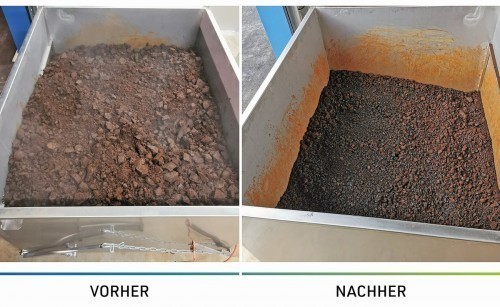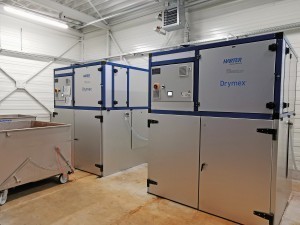The use of energy-saving heat pump technology is rewarded. A company receives state subsidies and also reduces its disposal costs.
An extremely innovation-driven company from Baden-Württemberg has discovered that there is a lot of money in waste sludge and has successfully implemented it. At Ätztechnik Herz GmbH & Co KG, waste sludge is generated during production. This is produced by precipitation during the waste water treatment of the chemical baths in the waste water treatment plant.
Previously, the sludge was mechanically dewatered in a chamber filter press, loaded into transport containers and taken to landfill. "The high costs for transportation and disposal had been a thorn in our side for some time," says Harald Mueller-Josten, Technical Manager at Herz. "We had realized that drying sludge offers great potential for savings." The fact that Herz received a state subsidy for this project was a welcome added bonus.
Mechanically pre-dewatered sludge still has an average water content of 60-70%. This means that the operator pays the majority of his disposal costs for water alone. Drying can reduce the weight and volume by up to 60 %, depending on the sludge. This also means a 60% reduction in disposal costs. If the landfill prices are correspondingly high, drying the sludge becomes a financially interesting calculation. This is made even more interesting by the use of particularly energy-saving drying technology.
 Fig. 2: Drying significantly reduces the volume, weight and, above all, the disposal costs of the sludge
Fig. 2: Drying significantly reduces the volume, weight and, above all, the disposal costs of the sludge
Herz, which operates in numerous industries worldwide, contacted the drying system manufacturer Harter from Stiefenhofen in the Allgäu region. The company developed condensation drying with heat pump technology 30 years ago and uses it for a wide range of applications. Drying pre-dewatered sludge is one of its oldest mainstays. Herz had a sludge sample tested in Harter's in-house technical center. The test showed that the weight of the sludge could be reduced by 71% (see Fig. 1). The economic analysis showed a good amortization period. The technology leader for etching technology therefore invested in two sludge dryers.
Variable adjustable degree of dry air
 Fig. 3: Dryer type M5 with 2 containers each, each with a volume of 1.5 m3Theseare two standard Drymex® M5 dryers, each with two drying containers. The containers each have a usable volume of 1.5m3. The procedure today is as follows: After pressing in a chamber filter press, the sludge is emptied into one of the two drying containers and transported to the sludge dryer by forklift truck and driven in. The doors of the compact system are closed and the drying process is started. Meanwhile, the second container is located under the chamber filter press for the next emptying. Each working day, Herz produces approx. 3 tons of sludge with a dry matter content of 26%. After approx. 20-24 hours of drying, this is approx. 86 %. The water removal capacity of the M5 dryers is approx. 800 l / 24 h. 0.4 kWh is required for 1 liter of water extraction. Once the set desired degree of dry air has been reached, the system switches off automatically via a humidity measurement. For subsequent emptying, the containers are equipped with a tipping device, with the help of which the dried sludge is simply and completely emptied into a transport container and then sent for disposal. The nominal output of an M5 sludge dryer is 13.3 kW.
Fig. 3: Dryer type M5 with 2 containers each, each with a volume of 1.5 m3Theseare two standard Drymex® M5 dryers, each with two drying containers. The containers each have a usable volume of 1.5m3. The procedure today is as follows: After pressing in a chamber filter press, the sludge is emptied into one of the two drying containers and transported to the sludge dryer by forklift truck and driven in. The doors of the compact system are closed and the drying process is started. Meanwhile, the second container is located under the chamber filter press for the next emptying. Each working day, Herz produces approx. 3 tons of sludge with a dry matter content of 26%. After approx. 20-24 hours of drying, this is approx. 86 %. The water removal capacity of the M5 dryers is approx. 800 l / 24 h. 0.4 kWh is required for 1 liter of water extraction. Once the set desired degree of dry air has been reached, the system switches off automatically via a humidity measurement. For subsequent emptying, the containers are equipped with a tipping device, with the help of which the dried sludge is simply and completely emptied into a transport container and then sent for disposal. The nominal output of an M5 sludge dryer is 13.3 kW.
Condensation drying with heat pump technology works with extremely dry air in an energetically closed circuit. What exactly is so special about it? At the heart of all drying systems is a dehumidification unit in which air is heavily dehumidified and heated. This air, which is now extremely dry and therefore unsaturated, is fed via an air duct system into the drying container in which the sludge to be dried is located. Due to the low relative humidity in the circulating air, the air now absorbs the moisture from the filter cake. The drying process begins. The now moist air is fed back into the dehumidification unit and cooled down. The water condenses and leaves the system. The dry air is then reheated and fed back into the container. The air circuit is closed. This system from Harter is demonstrably the only one on the market that can operate completely free of exhaust air.
Guiding the air
However, even the driest air is worth nothing if it does not reach where it is supposed to absorb the moisture. The right air flow plays a key role in any type of drying process. In sludge drying, it must be implemented in such a way that the unsaturated air can flow evenly through all areas of the filter cake. For this purpose, the drying containers are equipped with a specially developed aeration floor and individual air control technology. The powerful fans used for sludge drying are custom-made products that the drying system manufacturer has designed and implemented together with its suppliers. The perfect interplay of air dehumidification and air flow makes it possible to aerate larger bulk heights homogeneously and thus dry the sludge evenly and completely. The temperatures are usually between 40° and 50 °C.
State subsidies
Drying with Harter'sCO2-saving and exhaust air-free heat pump technology has been classified by the BAFA (Federal Office of Economics and Export Control) as a future-oriented technology and therefore meets the criteria for the relevant funding programs. Herz Ätztechnik was therefore also able to apply for the state subsidy. In order to overcome the bureaucratic hurdles, Harter found an energy consulting company as a partner that specializes in processing funding applications. "We took advantage of this offer and, in addition to this future-oriented project, we also benefited from a considerable sum of money from the state," says a satisfied Mueller-Josten.


